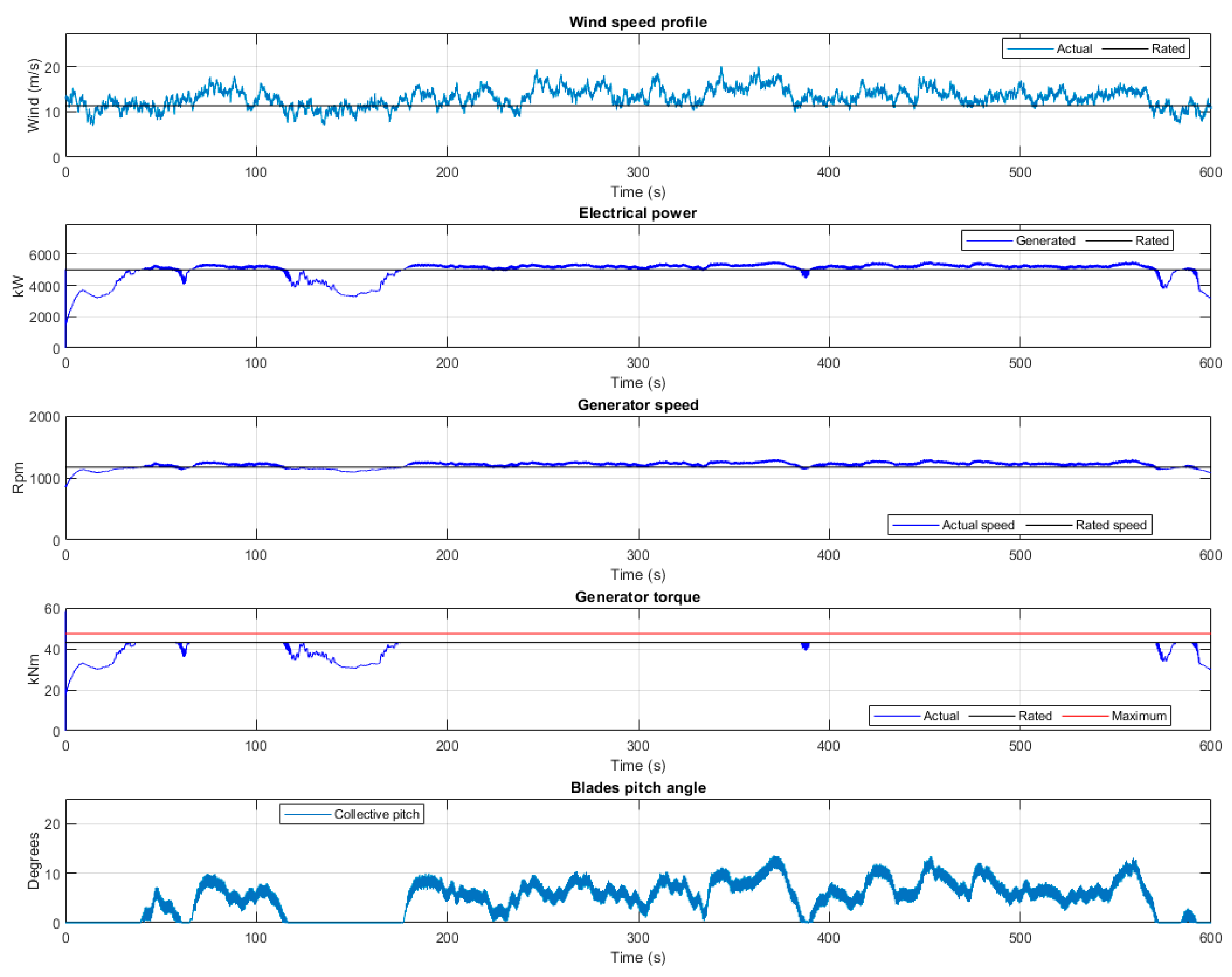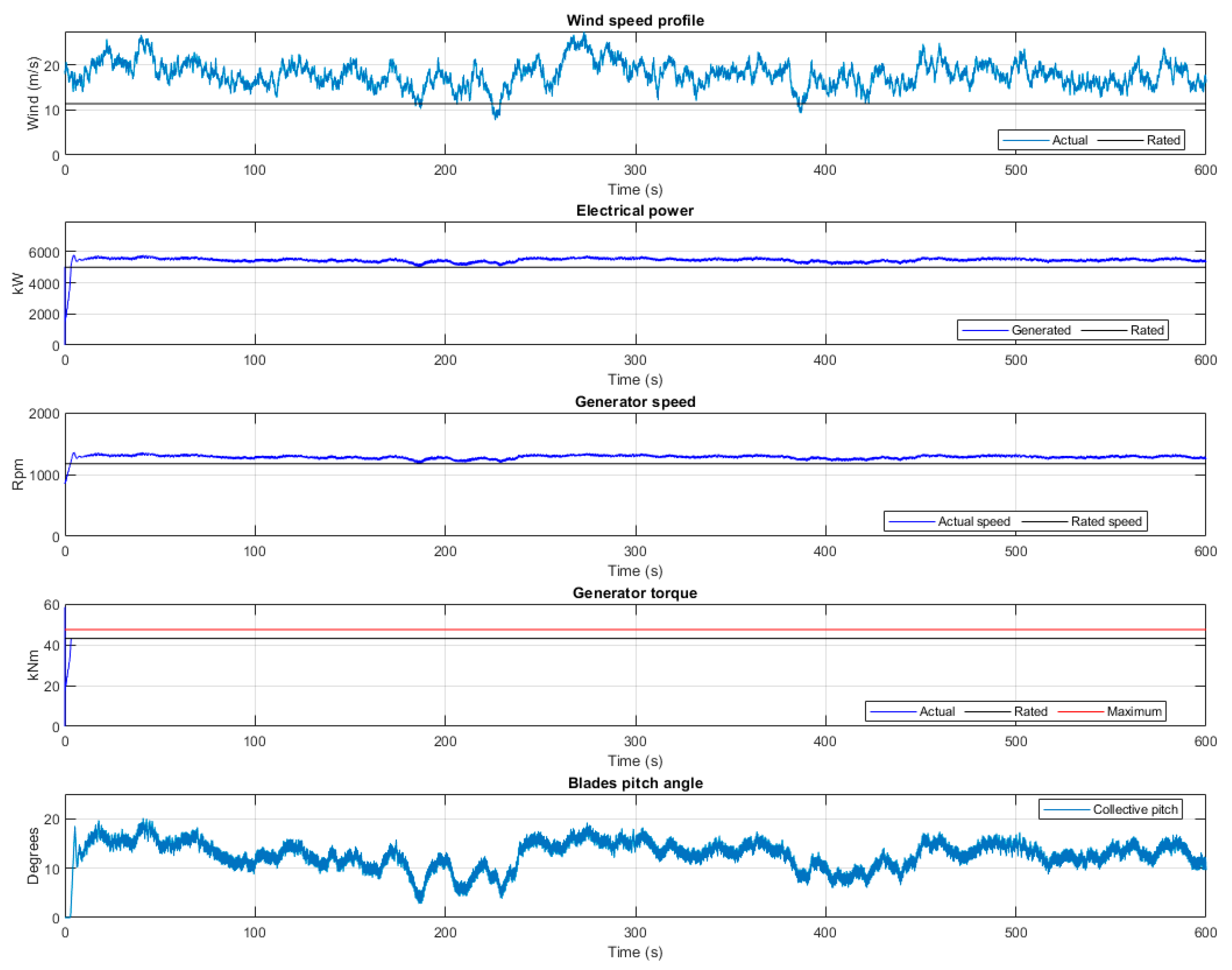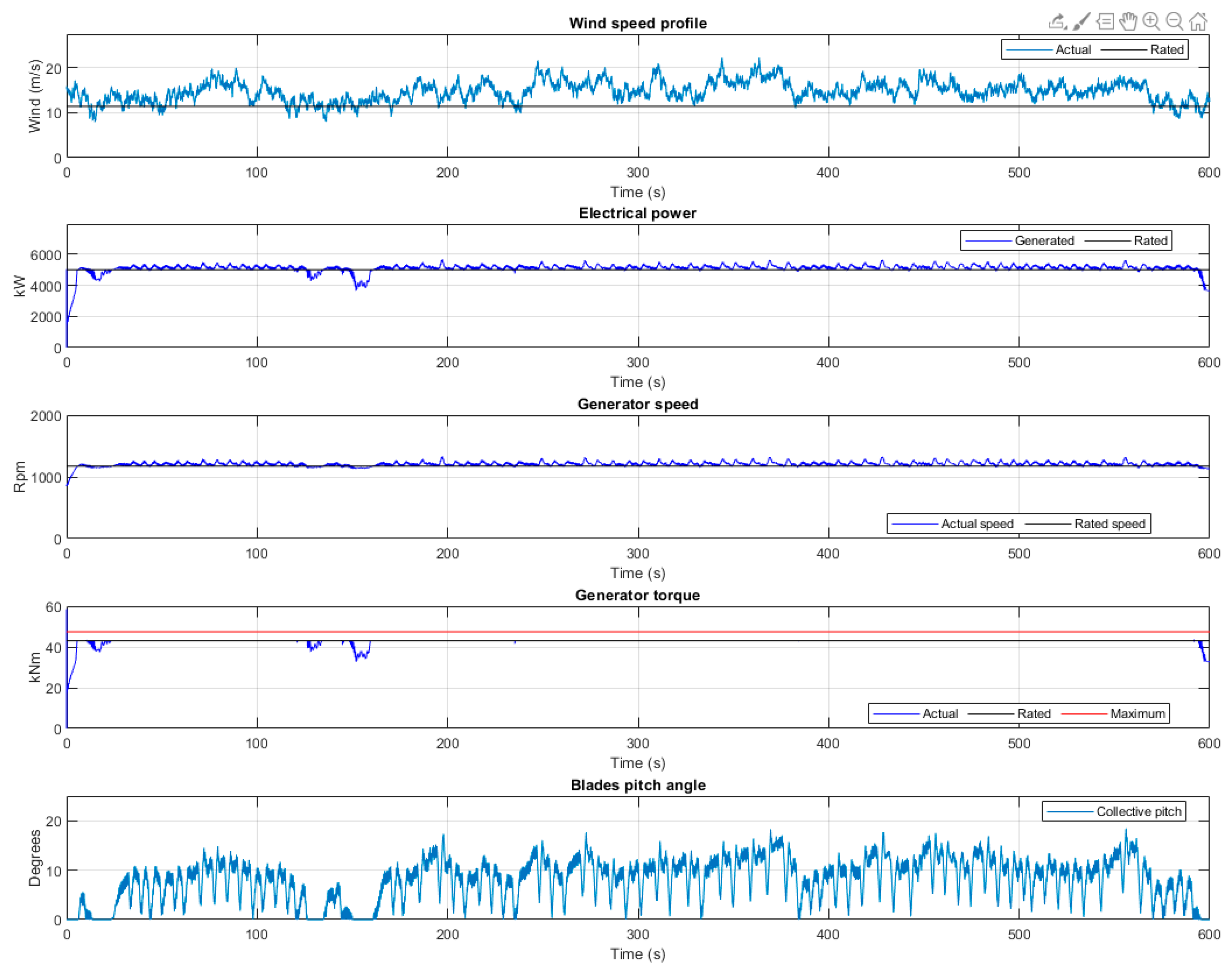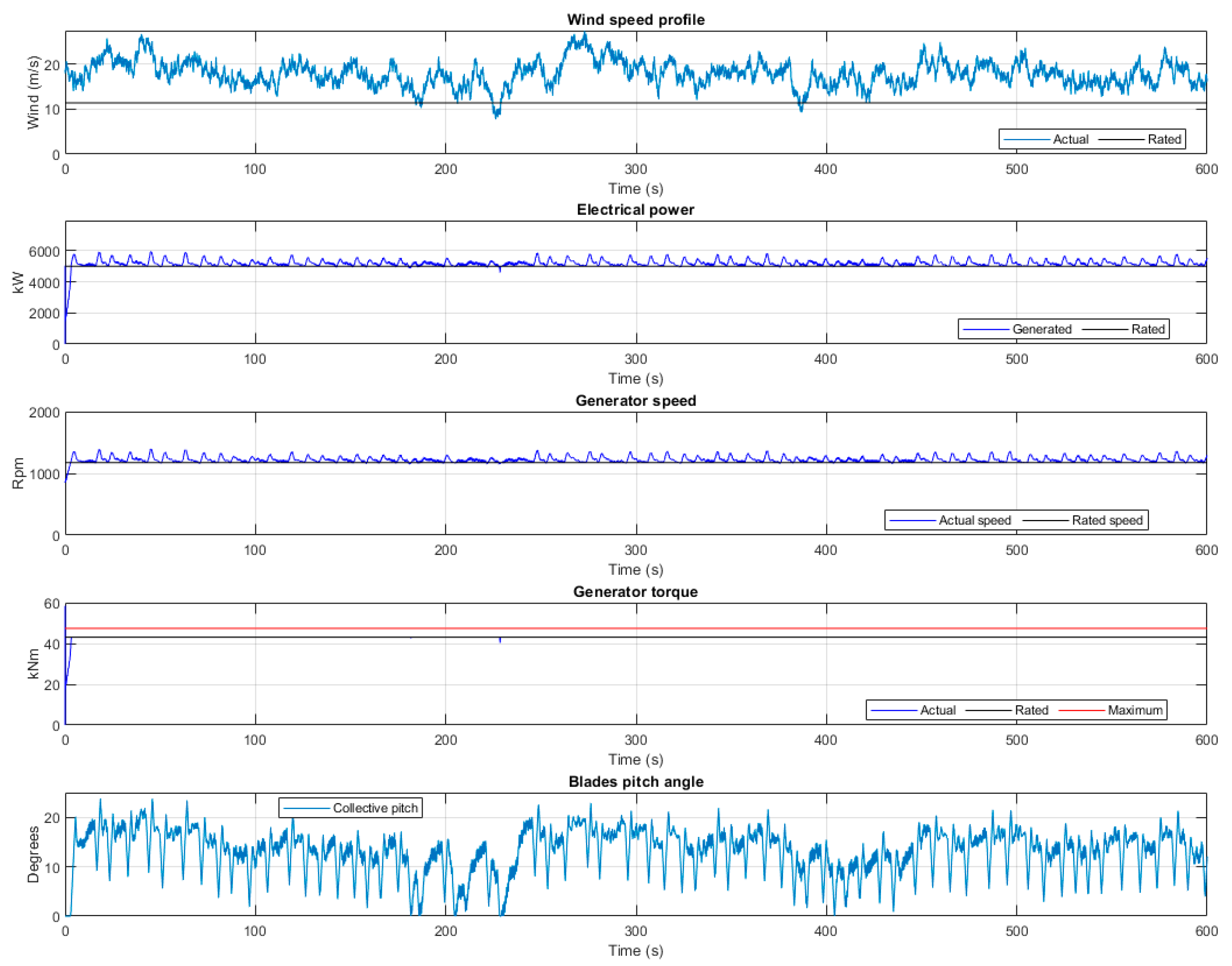Improving the Performance of Controllers for Wind Turbines on Semi-Submersible Offshore Platforms: Fuzzy Supervisor Control
Abstract
1. Introduction
2. System Description
2.1. Reference System
2.2. Parameters
2.3. Equations
2.4. Baseline Control
3. Methodology
3.1. Integration of Stand-Alone Simulation Tools
3.2. Performance Indexes
- Structural index, StI. It provides an estimation of the influence of the controller on the lifespan of the platform through the loads it produces on the structure. It is computed as the average of the absolute values of the reaction moment at the base of the wind turbine, for every time step, considering a rigid joint.
- Generation index, GI. It measures the difference in MW between the generated electric power and its rated value. It is calculated as the average of the absolute value of this difference, for every time step.
- Speed index, SpI. It shows the difference between the speed of the electric generator and its rated value. It is calculated as the average of the absolute value of this difference, for every time step.
3.3. Controller Configuration
4. Results
4.1. Comparison between the Controllers
4.2. Discussion of the Results
5. Conclusions
- Wind energy needs new locations to keep up with the growing trend, but these must be out of the continental platform. Semi-submersible platforms are an appealing option.
- The complex physical interactions between the wind turbine and the platform increase the difficulty to control the system. Intelligent controllers show interesting results and may suit this need.
- A methodology needs to be used to compare different controllers, and to design and enhance them. This must be based on an open-source simulation model and laid on solid performance metrics.
- Wind turbine operators are reluctant to abandon PI controllers in order to adopt new types of controllers. A technology like Fuzzy Logic that can be integrated with PIs is promising.
- The proposed methodology was used to design fuzzy controllers and to improve the reference PI by the development of an Anti-Wind-Up algorithm that helps the controller deal with the dynamics of the system.
- The supervisor fuzzy controller integrated with the reference PI and the Anti-Wind-Up (i.e., the improved PI) offers the best performance, while keeping the well-known PI in the control scheme. Precisely, these improvements are presented for scenarios with different wind profiles. In particular, an enhancement of 100% in some metrics was achieved.
Author Contributions
Funding
Institutional Review Board Statement
Informed Consent Statement
Data Availability Statement
Conflicts of Interest
References
- Diaz, J.; Vuelvas, J.; Ruiz, F.; Patiño, D. Modelo de predicción de demanda de energía eléctrica mediante técnicas Set-Membership. Rev. Iberoam. Autom. Inf. 2019, 16, 467–479. [Google Scholar] [CrossRef]
- Leung, D.Y.C.; Yang, Y. Wind energy development and its environmental impact: A review. Renew. Sustain. Energy Rev. 2012, 16, 1031–1039. [Google Scholar] [CrossRef]
- Sahin, A.D. Progress and recent trends in wind energy. Prog. Energy Combust. Sci. 2004, 30, 501–543. [Google Scholar] [CrossRef]
- Sebestyén, V. Renewable and Sustainable Energy Reviews: Environmental impact networks of renewable energy power plants. Renew. Sustain. Energy Rev. 2021, 151, 111626. [Google Scholar] [CrossRef]
- IRENA. Renewable Energy Capacity Statistics 2017; The International Renewable Energy Agency: Abu Dhabi, United Arab Emirates, 2017. [Google Scholar] [CrossRef]
- Martínez, E.; Sanz, F.; Pellegrini, S.; Jiménez, E.; Blanco, J. Life cycle assessment of a multi-megawatt wind turbine. Renew. Energy 2009, 34, 667–673. [Google Scholar] [CrossRef]
- Hevia-Koch, P.; Jacobsen, H.K. Comparing offshore and onshore wind development considering acceptance costs. Energy Policy 2019, 125, 9–19. [Google Scholar] [CrossRef]
- Castro-Santos, L.; Filgueira-Vizoso, A.; Carral-Couce, L.; Formoso, J.Á.F. Economic feasibility of floating offshore wind farms. Energy 2016, 112, 868–882. [Google Scholar] [CrossRef]
- Stenberg, C.; Christoffersen, M.; Mariani, P.; Krog, C.; Dolmer, P.; Maar, M.; Tørring, D. Offshore Wind Farms and Their Potential for Shellfish Aquaculture and Restocking; ICES CM 2010/O:12; Denmark Technical University: Lyngby, Denmark, 2010. [Google Scholar]
- Bossanyi, E.A. The design of closed loop controllers for wind turbines. Wind Energy 2000, 3, 149–163. [Google Scholar] [CrossRef]
- Azofra, D.; Jiménez, E.; Martínez, E.; Blanco, J.; Saenz-Díez, J.C. Wind power merit-order and feed-in-tariffs effect: A variability analysis of the Spanish electricity market. Energy Convers. Manag. 2014, 83, 19–27. [Google Scholar] [CrossRef]
- Red Eléctrica de España. El Sistema Eléctrico Español; Red Eléctrica de España: Alcobendas, Spain, 2017. [Google Scholar]
- Shahmaleki, P. Enhancing wind turbine’s performance using fuzzy pitch and torque controllers. In World Automation Congress Proceedings; IEEE: Stevenson, WA, USA, 2018. [Google Scholar] [CrossRef]
- UCTE. Final Report—System Disturbance on 4 November 2006. Union for the Coordination of Transmission of Electricity; UCTE: Brussels, Belgium, 2007. [Google Scholar]
- Thongam, J.S.; Ouhrouche, M. MPPT control methods in wind energy conversion systems. Fundam. Adv. Top. Wind Power 2011, 15, 339–360. [Google Scholar] [CrossRef]
- Pucci, M.; Cirrincione, M. Neural MPPT control of wind generators with induction machines without speed sensors. IEEE Trans. Ind. Electron. 2011, 58, 37–47. [Google Scholar] [CrossRef]
- Lin, W.-M.; Hong, C.-M. Intelligent approach to maximum power point tracking control strategy for variable-speed wind turbine generation system. Energy 2010, 35, 2440–2447. [Google Scholar] [CrossRef]
- Koutroulis, E.; Kalaitzakis, K. Design of a maximum power tracking system for wind-energy-conversion applications. IEEE Trans. Ind. Electron. 2006, 53, 486–494. [Google Scholar] [CrossRef]
- Heo, S.; Kim, M.; Choi, J. Hybrid intelligent control method to improve the frequency support capability of wind energy conversion systems. Energies 2015, 8, 11430–11451. [Google Scholar] [CrossRef]
- Abdullah, M.A.; Yatim, A.H.M.; Tan, C.W.; Saidur, R. A review of maximum power point tracking algorithms for wind energy systems. Renew. Sustain. Energy Rev. 2012, 16, 3220–3227. [Google Scholar] [CrossRef]
- Cheng, M.; Zhu, Y. The state of the art of wind energy conversion systems and technologies: A review. Energy Convers. Manag. 2014, 88, 332–347. [Google Scholar] [CrossRef]
- Li, Q.; Kamada, Y.; Maeda, T.; Murata, J.; Iida, K.; Okumura, Y. Fundamental study on aerodynamic force of floating offshore wind turbine with cyclic pitch mechanism. Energy 2016, 99, 20–31. [Google Scholar] [CrossRef]
- Zhu, H.; Sueyoshi, M.; Hu, C.; Yoshida, S. A study on a floating type shrouded wind turbine: Design, modeling and analysis. Renew. Energy 2019, 134, 1099–1113. [Google Scholar] [CrossRef]
- Santos Peñas, M.; Miranda Suescun, E. Aplicación de la lógica difusa en el ámbito de las energías renovables. Elementos 2012, 2, 101–114. [Google Scholar] [CrossRef][Green Version]
- Santos, M. Un enfoque aplicado del control inteligente. Rev. Iberoam. Autom. Inform. Ind. RIAI 2011, 8, 283–296. [Google Scholar] [CrossRef]
- Eltamaly, A.M.; Farh, H.M. Maximum power extraction from wind energy system based on fuzzy logic control. Electr. Power Syst. Res. 2013, 97, 144–150. [Google Scholar] [CrossRef]
- Aissaoui, A.G.; Tahour, A.; Essounbouli, N.; Nollet, F.; Abid, M.; Chergui, M.I. A Fuzzy-PI control to extract an optimal power from wind turbine. Energy Convers. Manag. 2013, 65, 688–696. [Google Scholar] [CrossRef]
- Kamal, E.; Aitouche, A.; Ghorbani, R.; Bayart, M. Robust fuzzy fault-tolerant control of wind energy conversion systems subject to sensor faults. IEEE Trans. Sustain. Energy 2012, 3, 231–241. [Google Scholar] [CrossRef]
- Jianzhong, Z.; Ming, C.; Zhe, C.; Xiaofan, F. Pitch angle control for variable speed wind turbines. In Proceedings of the 2008 Third International Conference on Electric Utility Deregulation and Restructuring and Power Technologies, Nanjing, China, 6–9 April 2008; IEEE: Piscataway, NJ, USA, 2008; pp. 2691–2696. [Google Scholar] [CrossRef]
- Soman, S.S.; Zareipour, H.; Malik, O.; Mandal, P. A review of wind power and wind speed forecasting methods with different time horizons. N. Am. Power Symp. 2010, 1, 1–8. [Google Scholar] [CrossRef]
- Abo-Khalil, A.G.; Dong-Choon, L.; Jul-Ki, S. Variable speed wind power generation system based on fuzzy logic control for maximum output power tracking. In Proceedings of the 2004 IEEE 35th Annual Power Electronics Specialists Conference (IEEE Cat. No.04CH37551), Aachen, Germany, 20–25 June 2004; IEEE: Aachen, Germany, 2004; pp. 2039–2043. [Google Scholar] [CrossRef]
- Lasheen, A.; Elshafei, A.L. Wind-turbine collective-pitch control via a fuzzy predictive algorithm. Renew. Energy 2016, 87, 298–306. [Google Scholar] [CrossRef]
- Jama, M.; Wahyudie, A.; Assi, A.; Noura, H. An intelligent fuzzy logic controller for maximum power capture of point absorbers. Energies 2014, 7, 4033–4053. [Google Scholar] [CrossRef]
- Schoen, M.P.; Hals, J.; Moan, T. Wave prediction and robust control of heaving wave energy devices for irregular waves. IEEE Trans. Energy Convers. 2011, 26, 627–638. [Google Scholar] [CrossRef]
- Falnes, J. Ocean Waves and Oscillating System: Linear Interactions Including Wave-Energy Extraction; Cambridge University Press: Cambridge, UK, 2002. [Google Scholar]
- Serrano-Barreto, C.; Santos, M. Intelligent fuzzy optimized control for energy extraction in large wind turbines. In Lecture Notes in Computer Science (Including Subseries Lecture Notes in Artificial Intelligence and Lecture Notes in Bioinformatics); Springer Science and Business Media Deutschland GmbH: Luxembourg, 2020; Volume 12490, pp. 269–276. [Google Scholar]
- Simoes, M.G.; Bose, B.K.; Spiegel, R.J. Fuzzy logic based intelligent control of a variable speed cage machine wind generation system. Power Electron. IEEE Trans. 1997, 12, 87–95. [Google Scholar] [CrossRef]
- Wakui, T.; Yoshimura, M.; Yokoyama, R. Multiple-feedback control of power output and platform pitching motion for a floating offshore wind turbine-generator system. Energy 2017, 141, 563–578. [Google Scholar] [CrossRef]
- Chavero-Navarrete, E.; Trejo-Perea, M.; Jáuregui-Correa, J.C.; Carrillo-Serrano, R.V.; Ríos-Moreno, J.G. Expert control systems for maximum power point tracking in a wind turbine with PMSG: State of the art. Appl. Sci. 2019, 9, 2469. [Google Scholar] [CrossRef]
- Sierra-Garcia, J.E.; Santos, M. Improving wind turbine pitch control by effective wind neuro-estimators. IEEE Access 2021, 9, 10413–10425. [Google Scholar] [CrossRef]
- Kariniotakis, G.N.; Stavrakakis, G.S.; Nogaret, E.F. Wind power forecasting using advanced neural networks models. IEEE Trans. Energy Convers. 1996, 11, 762–767. [Google Scholar] [CrossRef]
- Costa, A.; Crespo, A.; Navarro, J.; Lizcano, G.; Madsen, H.; Feitosa, E. A review on the young history of the wind power short-term prediction. Renew. Sustain. Energy Rev. 2008, 12, 1725–1744. [Google Scholar] [CrossRef]
- Wunsch, D.C.; O’Hair, E.A.; Giesselmann, M.G. Using neural networks to estimate wind turbine power generation. IEEE Trans. Energy Convers. 2001, 16, 276–282. [Google Scholar]
- Barbounis, T.G.; Theocharis, J.B.; Alexiadis, M.C.; Dokopoulos, P.S. Long-term wind speed and power forecasting using local recurrent neural network models. IEEE Trans. Energy Convers. 2006, 21, 273–284. [Google Scholar] [CrossRef]
- Aguilar, R.M.; Torres, J.M.; Martín, C.A. Aprendizaje Automático en la Identificación de Sistemas. Un Caso de Estudio en la Predicción de la Generación Eléctrica de un Parque Eólico. Rev. Iberoam. Autom. Inform. Ind. 2018, 16, 114. [Google Scholar] [CrossRef]
- Sierra-Garcia, J.E.; Santos, M. Performance analysis of a wind turbine pitch neurocontroller with unsupervised learning. Complexity 2020, 2020, 4681767. [Google Scholar] [CrossRef]
- Sierra-García, J.E.; Santos, M. Wind turbine pitch control first approach based on reinforcement learning. In Lecture Notes in Computer Science (Including Subseries Lecture Notes in Artificial Intelligence and Lecture Notes in Bioinformatics); Springer Science and Business Media Deutschland GmbH: Luxembourg, 2020; Volume 12490, pp. 260–268. [Google Scholar]
- Sierra-García, J.E.; Santos, M. Exploring reward strategies for wind turbine pitch control by reinforcement learning. Appl. Sci. 2020, 10, 7462. [Google Scholar] [CrossRef]
- Wei, C.; Zhang, Z.; Qiao, W.; Qu, L. Reinforcement-learning-based intelligent maximum power point tracking control for wind energy conversion systems. IEEE Trans. Ind. Electron. 2015, 62, 6360–6370. [Google Scholar] [CrossRef]
- González-González, A.; Etxeberria-Agiriano, I.; Zulueta, E.; Oterino-Echavarri, F.; Lopez-Guede, J.M. Pitch based wind turbine intelligent speed setpoint adjustment algorithms. Energies 2014, 7, 3793–3809. [Google Scholar] [CrossRef]
- Petković, D.; Ćojbašić, Ž.; Nikolić, V.; Shamshirband, S.; Kiah, M.L.M.; Anuar, N.B.; Wahab, A.W.A. Adaptive neuro-fuzzy maximal power extraction of wind turbine with continuously variable transmission. Energy 2014, 64, 868–874. [Google Scholar] [CrossRef]
- Ekinci, F.; Demirdelen, T.; Bilgili, M. Modelling of wind turbine power output by using ANNs and ANFIS techniques. In Proceedings of the 7th International Conference on Innovative Computing Technology (INTECH), Luton, UK, 16–18 August 2017; IEEE: Luton, UK, 2017. [Google Scholar] [CrossRef]
- Tomás-Rodríguez, M.; Santos, M. Modelling and control of floating offshore wind turbines. RIAI Rev. Iberoam. Autom. Inform. Ind. 2019, 16, 381–390. [Google Scholar] [CrossRef]
- Sacie, M.; López, R.; Santos, M. Exploratory data analysis of wind and waves for floating wind turbines in Santa María, California. In Lecture Notes in Computer Science (Including Subseries Lecture Notes in Artificial Intelligence and Lecture Notes in Bioinformatics); Springer Science and Business Media Deutschland GmbH: Luxembourg, 2020; Volume 12490, pp. 252–259. [Google Scholar]
- Cárdenas, R.; Peña, R. Sensorless vector control of induction machines for variable-speed wind energy applications. IEEE Trans. Energy Convers. 2004, 19, 196–205. [Google Scholar] [CrossRef]
- Chinchilla, M.; Arnaltes, S.; Burgos, J.C. Control of permanent-magnet generators applied to variable-speed wind-energy systems connected to the grid. IEEE Trans. Energy Convers. 2006, 21, 130–135. [Google Scholar] [CrossRef]
- EnerOcean, S.L. Home—EnerOcean. Available online: https://enerocean.com/ (accessed on 12 September 2021).
- Jonkman, J.; Butterfield, S.; Musial, W.; Scott, G. Definition of a 5-MW Reference Wind Turbine for Offshore System Development; National Renewable Energy Laboratory: Springfield, MO, USA, 2009. [Google Scholar] [CrossRef]
- Li, Y.; Castro, A.M.; Sinokrot, T.; Prescott, W.; Carrica, P.M. Coupled multi-body dynamics and CFD for wind turbine simulation including explicit wind turbulence. Renew. Energy 2015, 76, 338–361. [Google Scholar] [CrossRef]
- Robertson, A.; Jonkman, J.; Masciola, M.; Song, H.; Goupee, A.; Coulling, A.; Luan, C. Definition of the Semisubmersible Floating System for Phase II of OC4; National Renewable Energy Laboratory: Springfield, MO, USA, 2014. Available online: http://www.osti.gov/servlets/purl/1155123/ (accessed on 10 September 2021). [CrossRef]
- REpower Systems. REpower 5M; REpower Systems: Portland, OR, USA, 2010; pp. 1–12. [Google Scholar]
- Hau, E. Wind Turbines; Taylor and Francis: London, UK, 2013. [Google Scholar] [CrossRef]
- Kim, Y.S.; Chung, I.Y.; Moon, S.I. Tuning of the PI controller parameters of a PMSG wind turbine to improve control performance under various wind speeds. Energies 2015, 8, 1406–1425. [Google Scholar] [CrossRef]
- Vorpahl, F.; Schwarze, H.; Fischer, T.; Seidel, M.; Jonkman, J. Offshore wind turbine environment, loads, simulation, and design. Wiley Interdiscip. Rev. Energy Environ. 2013, 2, 548–570. [Google Scholar] [CrossRef]
- Jonkman, J.; Buhl, M.L. FAST User’s Guide; National Renewable Energy Laboratory: Springfield, MO, USA, 2005. [Google Scholar]
- Jonkman, B.J.; Jonkman, J.M. FAST v8.16.00a-bjj User’s Guide; National Renewable Energy Laboratory: Springfield, MO, USA, 2016; p. 58. [Google Scholar]
- Jonkman, J.; Sclavounos, P. Development of fully coupled aeroelastic and hydrodynamic models for offshore wind turbines. ASME Wind Energy Symp. 2006, 24, 995. [Google Scholar]
- Cordle, A.; Jonkman, J. State of the art in floating wind turbine design tools. Renew. Energy 2011, 8, 367–374. [Google Scholar]
- Jonkman, J.M.; Buhl, M.L. Development and verification of a fully coupled simulator for offshore wind turbines preprint. In Proceedings of the 45th AIAA Aerospace Sciences Meeting and Exhibit, Reno, NV, USA, 8–11 January 2007; American Institute of Aeronautics and Astronautics: Reno, NV, USA, 2007. [Google Scholar]
- Jonkman, J.; Larsen, T.; Hansen, A.; Nygaard, T.; Maus, K.; Karimirad, M.; Gao, Z.; Moan, T.; Fylling, I. Offshore code comparison collaboration within IEA Wind Task 23: Phase IV results regarding floating wind turbine modeling. In Proceedings of the European Wind Energy Conference (EWEC), Warsaw, Poland, 20–23 April 2010. [Google Scholar]
- Foley, J.T.; Gutowski, T.G. TurbSim: Reliability-based wind turbine simulator. In IEEE International Symposium on Electronics and the Environment; IEEE: San Francisco, CA, USA, 2008. [Google Scholar] [CrossRef]
- Future, O.E. TurbSim User’s Guide: Version 1.06.00; National Renewable Energy Laboratory: Springfield, MO, USA, 2012. [Google Scholar]
- Martynowicz, P. Real-time implementation of nonlinear optimal-based vibration control for a wind turbine model. J. Low Freq. Noise Vib. Act. Control. 2019, 38, 1635–1650. [Google Scholar] [CrossRef]
- Mayorga-Rubio, P.M.; Fernandez-Quijano, J.; Zambrana-Lopez, P.; Fernandez-Lozano, J.J.; Garcia-Cerezo, A.; Ortega-Casanova, J. Intelligent control for improving the efficiency of a hybrid semi-submersible platform with wind turbine and wave energy converters: Fuzzy control system for the wind turbine. Rev. Iberoam. Autom. Inform. Ind. 2019, 16, 480–491. [Google Scholar]
- Zambrana-Lopez, P.; Fernández-Quijano, J.; Fernandez-Lozano, J.J.; Garcia-Cerezo, A.; Mayorga-Rubio, P.M. Fuzzy logic tuning of a PI controller to improve the performance of a wind turbine on a semi-submersible platform under different wind scenarios. IFAC PapersOnLine 2020, 53, 12364–12371. [Google Scholar] [CrossRef]
- International Electrotechnical Commission. Wind Turbines—Part. 3: Design Requirements for Offshore Wind Turbines; IEC 61400-3:2009; International Electrotechnical Commission: Geneva, Switzerland, 2009. [Google Scholar]













| Parameter | Value |
|---|---|
| Rated power | 5 MW |
| Cut-in, Nominal, Cut-out wind speed | 3, 11.4 and 25 m/s |
| Number of blades, rotor topology | 3, upwind |
| Rotor, hub diameters | 126, 3 m |
| Hub height | 90 m |
| Regulation | Collective pitch, variable speed |
| Drivetrain, ratio | High speed, multi-stage gearbox, 1:97 |
| Rotor, generator rated speed | 12.1, 1173.7 rpm |
| Efficiency | 94.4% |
| Wind Mean Speed (m/s) | Baseline PI + Supervisor Fuzzy | Improved PI + Supervisor Fuzzy | Independent Fuzzy Controller |
|---|---|---|---|
| 13 | 69.1708 | 69.7611 | 70.2202 |
| 15 | 62.0628 | 61.9917 | 63.2591 |
| 18 | 51.7847 | 51.8146 | 53.1199 |
| Wind Mean Speed (m/s) | Baseline PI + Supervisor Fuzzy | Improved PI + Supervisor Fuzzy | Independent Fuzzy Controller |
|---|---|---|---|
| 13 | 0.3349 | 0.3349 | 0.4193 |
| 15 | 0.3310 | 0.2105 | 0.3809 |
| 18 | 0.4786 | 0.2318 | 0.6129 |
| Wind Mean Speed (m/s) | Baseline PI + Supervisor Fuzzy | Improved PI + Supervisor Fuzzy | Independent Fuzzy Controller |
|---|---|---|---|
| 13 | 51.0791 | 34.5912 | 57.5163 |
| 15 | 70.2047 | 39.9463 | 83.0064 |
| 18 | 110.4390 | 52.4833 | 141.9723 |
Publisher’s Note: MDPI stays neutral with regard to jurisdictional claims in published maps and institutional affiliations. |
© 2021 by the authors. Licensee MDPI, Basel, Switzerland. This article is an open access article distributed under the terms and conditions of the Creative Commons Attribution (CC BY) license (https://creativecommons.org/licenses/by/4.0/).
Share and Cite
Zambrana, P.; Fernandez-Quijano, J.; Fernandez-Lozano, J.J.; Rubio, P.M.M.; Garcia-Cerezo, A.J. Improving the Performance of Controllers for Wind Turbines on Semi-Submersible Offshore Platforms: Fuzzy Supervisor Control. Energies 2021, 14, 6222. https://doi.org/10.3390/en14196222
Zambrana P, Fernandez-Quijano J, Fernandez-Lozano JJ, Rubio PMM, Garcia-Cerezo AJ. Improving the Performance of Controllers for Wind Turbines on Semi-Submersible Offshore Platforms: Fuzzy Supervisor Control. Energies. 2021; 14(19):6222. https://doi.org/10.3390/en14196222
Chicago/Turabian StyleZambrana, Pablo, Javier Fernandez-Quijano, J. Jesus Fernandez-Lozano, Pedro M. Mayorga Rubio, and Alfonso J. Garcia-Cerezo. 2021. "Improving the Performance of Controllers for Wind Turbines on Semi-Submersible Offshore Platforms: Fuzzy Supervisor Control" Energies 14, no. 19: 6222. https://doi.org/10.3390/en14196222
APA StyleZambrana, P., Fernandez-Quijano, J., Fernandez-Lozano, J. J., Rubio, P. M. M., & Garcia-Cerezo, A. J. (2021). Improving the Performance of Controllers for Wind Turbines on Semi-Submersible Offshore Platforms: Fuzzy Supervisor Control. Energies, 14(19), 6222. https://doi.org/10.3390/en14196222






